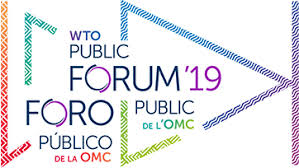Rethinking services trade in a digital world
8 Oct 2019 02:00h
Event report
[Read more session reports from WTO Public Forum 2019]
Mr Alan Winters (Professor of Economics, Sussex University) opened the session by saying that although digitisation favours trade in many circumstances, it also has a disruptive effect thus posing challenges to the existing trade regulations.
Ms Cosmina Dorobantu (Deputy Director, Programme for Public Policy, Alan Turing Institute) first explained that digitisation has impacted services in four ways. First, the provision of services has been disrupted since the line between the location where the service is provided and the place where it is consumed is blurred. New services have emerged as it is the case of cloud computing. The market place has changed: online platforms have now emerged as a place where service providers and consumers meet. Finally, the distinction between goods and services is blurred because increasingly more goods are purchased with a service plan included. Dorobantu then affirmed that data, codes (i.e. algorithms), and platforms will be the main players of digitisation in the upcoming years. It follows that the arising policy concerns will be grouped around these three elements. For instance, more and more countries are regulating the protection of data, the access to data, and the localisation requirements individually or within regional frameworks (i.e. whether data should be stored locally or not). The same applies to the scrutiny over codes (already required by some trade agreements) and to platforms, as to whether they can be considered content providers as well, thus entailing their responsibility for the content that is shared within.
Mr Ingo Borchert (Senior Lecturer in Economics, Sussex University) addressed the impact of digitisation on the costs of trade transactions and considered two dimensions: how services can be traded and how they can be regulated. Borchert approached the issues starting from three main questions. First, has digitisation led to a fall in services trade costs? The answer is affirmative because the development of digitisation enhances the cross-border tradeability of services. For example, compared to physical goods and agricultural products, trade costs for services have dwindled much more in the past few years. Second, how will services be traded? In the future, we will witness a growth of ICT-enabled services especially in regard to telecom, computer, personal, cultural, and business services. Moreover, the demarcation between goods and services will be progressively blurred: Many services will make their way into the manufacturing process – nowadays, many goods are already sold with a service embedded within. Third, what are the challenges to regulating services and trade? With the distinction between goods and services being blurred, traditional categories of regulation will be even more challenged. Therefore, non-trade and cross-cutting policy areas will be increasingly salient for the regulation of services trade. For example, trading services will involve the intellectual property legal framework to a greater extent because intangible assets will be increasingly traded on the market. For instance, with the development of the 3D printing technology, the trade of goods will be partially replaced by the trade of designs.
Mr Amar Breckenridge (Senior Associate, Frontier Economics) talked about the arising policy issues and challenges to the existing trade rules and the General Agreement on Trade in Services (GATS). Breckenridge first explained that digitisation is changing the way trade happens by increasing the concentration of market power to platforms, by reducing the fixed costs associated with the entry to the market and by blurring the distinction between goods and services and the modes of supply. Moreover, digitisation is also making data both an enabler of trade and a commodity to be traded with a high fixed cost of acquisition, but a lower marginal cost (as it is not expensive to be reproduced). The unfolding of the digital economy has blurred the line among the four traditional modes of service supply that are at the base of the GATS architecture, namely, cross-border supply, consumption abroad, commercial presence, and the movement of natural persons. This poses both regulatory and policy concerns.
On the regulatory side, Breckenridge analysed the existing regional trade agreements (RTAs) as solutions for a more liberal approach towards service regulation. In such a context, modelling shows that data-flow liberalisation delivers the biggest kicks to digitally-intensive sectors only in developed countries. Despite the advantages enumerated, RTAs still present challenges when it comes to assessing the optimal trade-offs on regulation and to determining which sectors benefit the most from the trade of services.
On the policy side, Breckenridge believes that the concentration effects deriving from the existence of very powerful players on the market are testing the existing competition policy tools. Moreover, he said that the policy debate will eventually encompass the discourse around public good and to what extent security can be valued as such.
Related topics
Related event

